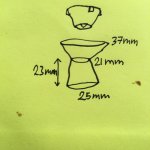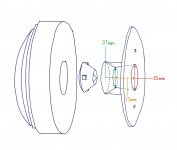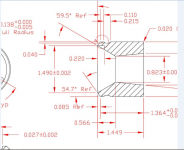I am thinking of upgrading the mids on my 3-way horn system to a Volti FC260 tractrix, but am undecided on the driver. Many phenomenal systems have been built using the BMS 4592ND-MID (around $650 each), so that is a top contender. Much of what I read, and a little of what I have physically auditioned, however swears by Beryllium... which seem significantly absent from posts. Admittedly that was with Classic Audio Systems that had not only Beryllium but also field coil drivers Beryllium plus field coil is out of my price range - and it's impossible to separate variables. Looking at new Beryllium, Radian drivers look amazing... except for the prices: 760NEOBePB at $850 each, or the 950BePB at $1100. True, that is a big increase, but in the long run... in for a penny in for a pound. Three years from now I will have forgotten about the extra money. So... anyone out there have insights or experience on this? I am probably willing to spend the dough, but would rather not unless truly a significant step up. I tri-amp so efficiency is not an issue, and I am satisfied with all other specs.
Thanks.
Thanks.
Beryllium diaphragms push the high frequency resonance peak and breakup higher than aluminum, titanium, or plastic, allowing large diaphragm (3"-4") high frequency response to sound "cleaner".I am thinking of upgrading the mids on my 3-way horn system to a Volti FC260 tractrix, but am undecided on the driver. Many phenomenal systems have been built using the BMS 4592ND-MID (around $650 each), so that is a top contender. Much of what I read, and a little of what I have physically auditioned, however swears by Beryllium...
The BMS 4592ND-MID is designed for midrange, (300-7kHz) using a Polyester diaphragm, which can go lower with less distortion than metal diaphragms designed to go all the way up to 16-20kHz.
The BMS 4592ND is a co-axial mid/hi driver using two separate Polyester annular ring diaphragms, the HF diaphragm is small and light enough that the HF peak (around 19kHz) is as high as a larger Beryllium diaphragm.
If you plan to use a separate tweeter above the FC260, the expense of Beryllium is probably unwarranted, as the primary advantages are in performance above 10kHz.
If you want to cross below around 600 Hz, the BMS drivers may be preferable, especially if you like to listen to big band or orchestral music at "live" levels.
Art
To be honest I don't necessarily agree with you on that point...
In my experience Be tends to yield more resolution and a greater sense of ease and air in the high frequency. While I understand that that statement is entirely subjective (although there was a white paper somewhere comparing Be, PG, Boron and a Boron Ti composite, can't find it now of course, but anyway), I really do think it would be worth it to order both from USspeakers. The owner is a fair and honest guy who I'm sure if you were to give him a call would at least be willing to try and help you out. Ultimately, if you do go the Radian route, make sure you get a Materion Truextent Be diaphragm as they are so much better than aluminum and even the Radian's own Be diaphragm.
I think they make a 4 inch drop in replacement diaphragm for the Radian 950PB... I've seen them before for about 600$ on some website. At 600 each, they represent the price difference between the same compression driver, but just outfitted with aluminum compared to stock Radian Be diaphragm.
Hope this helps,
Clashing
In my experience Be tends to yield more resolution and a greater sense of ease and air in the high frequency. While I understand that that statement is entirely subjective (although there was a white paper somewhere comparing Be, PG, Boron and a Boron Ti composite, can't find it now of course, but anyway), I really do think it would be worth it to order both from USspeakers. The owner is a fair and honest guy who I'm sure if you were to give him a call would at least be willing to try and help you out. Ultimately, if you do go the Radian route, make sure you get a Materion Truextent Be diaphragm as they are so much better than aluminum and even the Radian's own Be diaphragm.
I think they make a 4 inch drop in replacement diaphragm for the Radian 950PB... I've seen them before for about 600$ on some website. At 600 each, they represent the price difference between the same compression driver, but just outfitted with aluminum compared to stock Radian Be diaphragm.
Hope this helps,
Clashing
You don't mention what you are upgrading from?
Well I've had the BMS and thought it was "bleached out" and resonant sounding, and not in a good way. I have had Radian drivers but not the Be models but have TAD 4001, 4002 and much preferred them over the BMS. The TAD's have much higher resolution and deep tone that can be very convincing. The Community M200 has the tone of the TAD but in a more natural way where the driver doesn't draw attention to itself and shout out "listen to me I am TAD" - as far as resolution goes the TAD probably has a slight edge over M200 but only where the 4002 is used without the throat adapter and in a 1.5" short horn.
The community is really only good to 3-4k so keep that in mind.
Well I've had the BMS and thought it was "bleached out" and resonant sounding, and not in a good way. I have had Radian drivers but not the Be models but have TAD 4001, 4002 and much preferred them over the BMS. The TAD's have much higher resolution and deep tone that can be very convincing. The Community M200 has the tone of the TAD but in a more natural way where the driver doesn't draw attention to itself and shout out "listen to me I am TAD" - as far as resolution goes the TAD probably has a slight edge over M200 but only where the 4002 is used without the throat adapter and in a 1.5" short horn.
The community is really only good to 3-4k so keep that in mind.
Last edited:
Well I have live with fc260 and bms 4592nd-mid for 3 years. It is a very good combination, if you use volti's crossover too. It is a very good combination. Only the tweeter placement is problematic with volti. I suggest putting the tweeter on top and in alignment with the bms. I used a fostex t500amkII with it, with volti crossover and it was sounding very very good.
I also have Radian be and Radian standart drivers. i do not have enough experience them on yet to say much and I use Radians half an octave narrower than I used bms. Radian sounds relaxed and detailed.
It is very much in the implementation and not only in the driver, do not forget that. Even small changes can change the character of the sound.
I also have Radian be and Radian standart drivers. i do not have enough experience them on yet to say much and I use Radians half an octave narrower than I used bms. Radian sounds relaxed and detailed.
It is very much in the implementation and not only in the driver, do not forget that. Even small changes can change the character of the sound.
Hey All, I am Dennis with Radian Audio. Got a call about this thread, so I thought I would come in and clear some stuff up. All our products use Materion Truextent BE domes with our composite(a propitiatory blend) mounting rings. We have been working with Materion from the start. Their 950 BE diaphragm was the first product they came out with in beryllium. All our 950 series use their diaphragms to this day.To be honest I don't necessarily agree with you on that point...
When it comes to pricing that is out of my hands. I can tell you this. BE is a pain to work with, from mining the ore to processing of the raw material into a usable product it is time consuming and labor intensive. Also, to add it is not a forgiving material.
I hope this clears some things up. You can always contact us if you have any questions.
It could be both are true. 
From looking at a lot of measurements, the breakup modes tend to be higher in Be drivers, but also, the waterfall plots much cleaner. However, from what I've seen in domes, the break up/resonance of Be domes is not much different than aluminum or other metal dome's. I have not looked at a lot of compression drivers however.
Where I tend to dislike the Be domes drivers is in tonal accuracy. I've not yet seen one as flat as the best ribbon or AMT drivers. However, subjectively I'm also less sensitive to this than I am sensitive to stored energy/ringing so I'd take a good Be dome over most good dome's. I'd take a good ribbon or AMT over those.
Thanks a lot for the recommendation on the Be diaphragm! I keep thinking about making a coaxial 2-way with the Radian. Having a better Be replacement is a good thing.
Best,
Erik
From looking at a lot of measurements, the breakup modes tend to be higher in Be drivers, but also, the waterfall plots much cleaner. However, from what I've seen in domes, the break up/resonance of Be domes is not much different than aluminum or other metal dome's. I have not looked at a lot of compression drivers however.
Where I tend to dislike the Be domes drivers is in tonal accuracy. I've not yet seen one as flat as the best ribbon or AMT drivers. However, subjectively I'm also less sensitive to this than I am sensitive to stored energy/ringing so I'd take a good Be dome over most good dome's. I'd take a good ribbon or AMT over those.
Thanks a lot for the recommendation on the Be diaphragm! I keep thinking about making a coaxial 2-way with the Radian. Having a better Be replacement is a good thing.
Best,
Erik
To be honest I don't necessarily agree with you on that point...
Last edited:
I know this is an old thread but after I bought Radian 475 Beryllium compression drivers from us speaker, I tried 5 times with e-mail for support and never got any response to my requests to know the exit angle of the driver and to see response graphs. Nothing was supplied with the drivers themselves as far as this basic and very needed information.Hey All, I am Dennis with Radian Audio. <snip>
Googling "Radian 745 Exit angle" leads to:
https://www.parts-express.com/pedoc...pb-1.4-inch-compression-driver-data sheet.pdf

I wonder how good a match it would be with this one (made for a driver with 10.5 degrees exit angle):
CIARE ITALIAN SPEAKERS - PRO AUDIO B2B: PR 614 HORN 1.4 INCH
BTW: Vance Dickason tested the Radian 745 with both versions of diaphragms:
The 745NEOBe Compression Driver from Radian Audio | audioXpress
Regards
Charles
https://www.parts-express.com/pedoc...pb-1.4-inch-compression-driver-data sheet.pdf
I wonder how good a match it would be with this one (made for a driver with 10.5 degrees exit angle):
CIARE ITALIAN SPEAKERS - PRO AUDIO B2B: PR 614 HORN 1.4 INCH
BTW: Vance Dickason tested the Radian 745 with both versions of diaphragms:
The 745NEOBe Compression Driver from Radian Audio | audioXpress
Regards
Charles
I know this is an old thread but after I bought Radian 475 Beryllium compression drivers from us speaker, I tried 5 times with e-mail for support and never got any response to my requests to know the exit angle of the driver and to see response graphs. Nothing was supplied with the drivers themselves as far as this basic and very needed information.
Call back and ask specifically for Dennis Stamatoiu. He the one person there that knows all the tech inside & out.
They are definitely not good with supplying graphs & other test data, though.
Also, from doing a lot of reading, in the recent past Radian has been guilty of playing fast & loose with the facts, so caveat etc....
But Dennis is very cool.
Other notes:
1: Whatever product you use, make sure it's made with pure beryllium. Evidently there's a lot of stuff now made (more cheaply) with other materials & a beryllium overlay, or whatever, and it's marketed the same but is very definitely NOT the same.
2: Consider other options with new technology. Some B&C titanium drivers use new polymer surrounds (polymide?) which they claim smooth out the sound of titanium, and Radian does something similar with their aluminum (not titanium) diaphrams.
In a perfect world, I'd want to audition all these options before spending all that money on Beryllium. (Even though I probably will.
Altec Lansing introduced the polymer surround 808 aluminum diaphragm around 1973, as I recall.2: Consider other options with new technology. Some B&C titanium drivers use new polymer surrounds (polymide?) which they claim smooth out the sound of titanium, and Radian does something similar with their aluminum (not titanium) diaphrams.
B&C and Radian (and many others) make some fine drivers, but nothing new about using polyamides, or charging 6 times as much for a Be diaphragm surrounded by the stuff...
- Home
- Loudspeakers
- Multi-Way
- BMS 4592 vs Radian Beryllium


